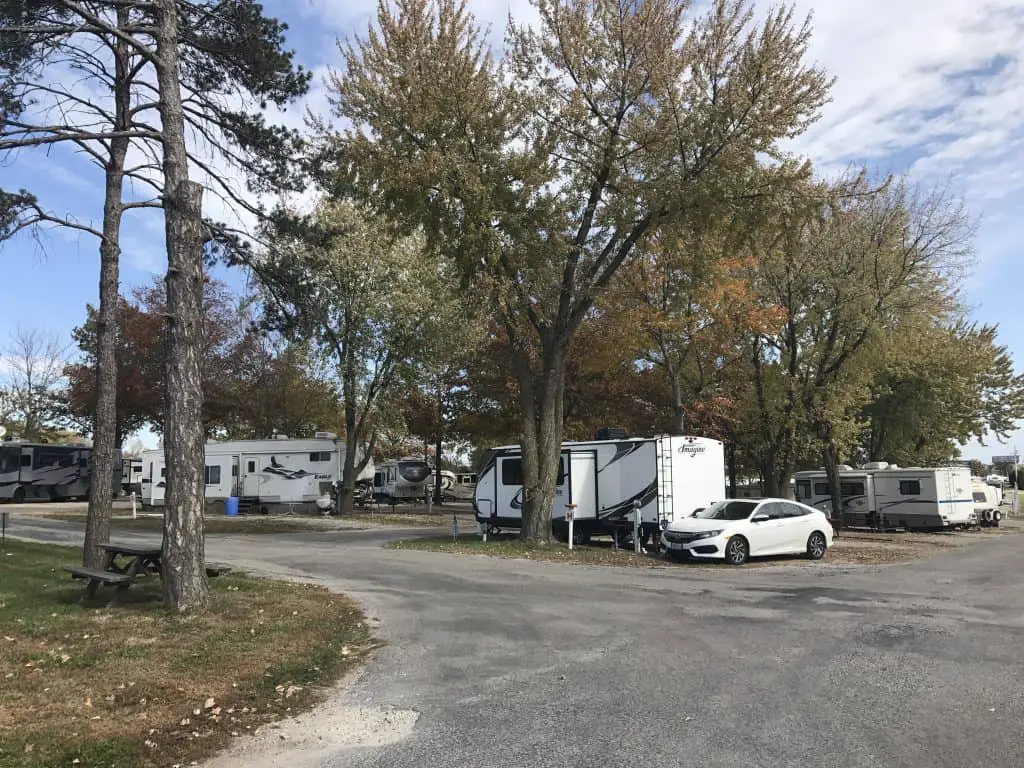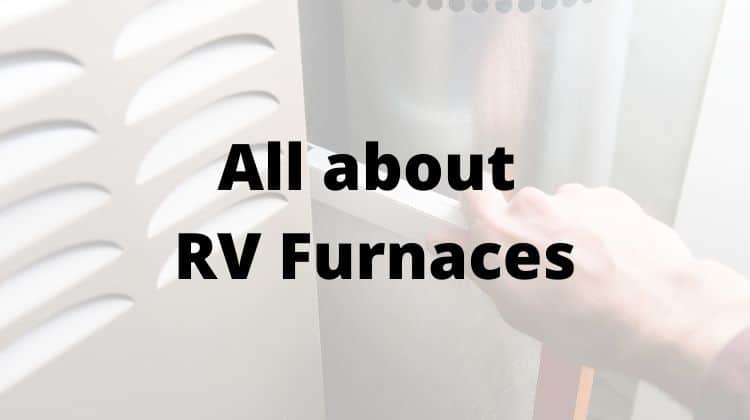
While workamping at a campground in Missouri one winter, we would occasionally have people come into the campground that had no idea how to turn on their RV furnace. There were quite a few times I would have to go into their camper and show them how to turn on their furnace.

With that in mind, I decided to create a post that answers common questions about RV furnaces.
How does a furnace work in an RV?
How does an RV heater work? An RV heater is generally a constrained air framework that is controlled by both propane and power. Propane warms the framework and power makes the fan move.
How to start an RV furnace
With regards to keeping you comfortable on those cold evenings, your RV heater is vital. As usual, counsel your proprietor’s manual if feasible for directions explicit to your unit. Extra advances might be required.
1. Turn On Your Tank
This is an important step. If you don’t have your propane tanks turned on, then your furnace won’t heat. Next, turn your fan to auto, and turn your indoor regulator to the most noteworthy warmth setting. Let the fan run for a couple of moments.
2. Press Pilot Knob
Go to your heater get to board and expel its spread. Turn your gas dial to the pilot position and hold down the handle.
3. Light the Pilot
On the off chance that you have a striker start gadget, press it a few times. You can likewise light the pilot burner with a lighter or match. Discharge the handle and go it to the “on” position.
On the off chance that the pilot isn’t touched off, attempt again and hold down the handle longer this time. Set the indoor regulator to the temperature you want.
Do RV furnaces run on electricity?
In case you’re pondering, “Is my RV heater gas or electric?” the appropriate response is very likely gas. However, the unit does utilize power to touch off and to run the blowers. You may likewise have an electric warmer on board as a feature of your HVAC framework.
While conventional RV heaters don’t run on power alone, and undeniably high number of RV proprietors are selecting to supplant their propane-filled warmers with ones that sudden spike in demand for elective fuel sources — or possibly include some extra warming alternatives.
An electric RV heater or convenient warmer is the most normally utilized other option. To assist perusers with picking between a regular propane radiator and an electric RV heater, this article will thoroughly analyze the qualities and shortcomings of both warming frameworks and further profile the most predominant choices of electric RV heaters.
How much propane does an RV furnace use?
So how much propane does your RV furnace use? At the point when our family began living fulltime in our RV, we needed to make sense of how to keep warm, yet additionally, monitor how much propane we were utilizing. The answer to this question depends on a few different things.
The measure of propane utilized by a heater relies upon the size of the heater. The bigger the heater, the more propane it will utilize.
Some other things you will want to take into account is how big your RV is and how warm you want to keep it. In our 34′ camper, we used both our propane furnace and electric heaters to heat the camper in Missouri. We went through a 100 lb propane tank in about 3 weeks.
On average though most people went through a 100 lb tank in about a week. I saw one lady that kept her camper at 80 degrees. She would leave the camper door open while she would run outside to do something. She couldn’t understand why she was going through a 100 lb tank every few days.

Top Five Reasons for does not it fire up
1. The Thermostat
In spite of the fact that this may appear glaringly evident, be certain your indoor regulator is set to warm and that it’s really colder in your home than the temperature the indoor regulator is set to.
On the off chance that it is neither of these reasons causing the issue, have a go at turning the fan change to “on” to drive the heater to begin blowing air.
In the event that your heater still will not turn on, check your programmable indoor regulator for a blunder code.
Frequently, fresher electronic indoor regulators will show a blunder code if something isn’t right. Check the presentation and check whether it mentions to you what the issue is.
On the off chance that regardless it doesn’t work, after you have attempted those choices, the issue is most likely marginally more dubious than a basic indoor regulator fix. Keep checking to see what some different causes might be.
2. The Gas Line
As a matter of first importance, check that the gas is turned on. You can confirm this by inspecting the shunt valve which is outside.
Another simple method to tell if the gas is on and working appropriately is by beginning another item that uses gas like your stove.
On the off chance that it appears as though the gas line isn’t the issue and the gas is streaming to different items, check to ensure the gas supply to the heater itself is open and clear.
If the gas supply to the heater is disrupted, your heater may not be getting the fuel that it needs to run properly.
At long last, in the event that you smell gas or accept there is a hole, clear your home promptly and call an expert to assess the crisis issue.
3. The Furnace
The furnace itself could be the reason for the issue.
The switch inside the heater could have unintentionally been changed to off, so be certain the switch is turned on. Please note that not all furnaces have this switch.
Regardless of whether you have a gas framework, it still utilizes power and should be turned on. There should be a force disengage switch by the heater.
You can also check the breaker to ensure capacity to the heater has not been tripped. In the event that it has been tripped, make certain to turn it off and then back on. If the breaker keeps on tripping, call an HVAC professional since something isn’t right.
4. The Filter
Probably the least demanding answer for fixing a messed up heater is changing the air filter.
First, check to ensure the heater filter is clean and not plugged with dirt. If the filter does not need to be changed, make sure that all the vent registers are away from furniture and different blockages.
In the event that this doesn’t tackle the issue, you may need to employ an expert organization to clean your air pipes if the wind current is still not right.
5. The Pilot Light (Faulty Ignition Sensor)
The pilot light or start sensor is typically the most widely recognized issue when your heater won’t touch off.
This is commonly the issue on the off chance that you can hear your heater click on yet it doesn’t startup. A defective or grimy start or sensor is generally simple to fix.
To start with, you have to kill the gas to the heater. At that point, expel the front board to discover the ignitor or start sensor. This is commonly situated close to the burners.
In the event that the sensor or ignitor is grimy, it should be cleaned. Remove it with a screwdriver and clean it while being mindful so as not to break it.
Put the front board back on and turn on the gas back on. Turn up the temperature on your indoor regulator to check whether your heater will presently startup.
If this is the first time you are trying to light your gas heater this season, keep in mind that a heater that starts with a standing pilot light may require a long time to light. The reason for this is because the fuel has to travel through the empty lines to get to the pilot light.
Try to be patient since the thermocouple needs to get hot first, however hypothetically, your heater should begin to work now.
Is it cheaper to heat with propane or electricity?
This depends on if you are paying for electricity or not at the campground you are staying at. In some campgrounds, electricity is paid separately and it costs quite a bit. Please note that campers are designed to be heated with propane. The heat lines run along the tanks and water lines to help keep them from freezing as easy.
We typically run both propane and electric heat to help even out the costs unless the electricity is too high. Most of the time, it is cheaper to run your propane, but if you get free electricity with your campsite than it is cheaper to use electricity.
Why is my furnace running but no heat?
Typically when your RV furnace is running but there is no heat coming out, it means that you are either out of propane or your propane line has a block in it.
You will want to keep in mind that even though your RV might have a gauge in it that tells you how much propane you have left, those gauges are not always accurate. I have seen many times where people thought they still had propane, but it turned out their tank was completely empty.
Why is my furnace not kicking on?
A heater not kicking on is one of the most frustrating things of the winter. There you are settled in on a nippy winter late evening watching movies. You turn up the temperature in your RV a few more degrees and nothing.
In a perfect world, the issue of your heater not turning on will occur during the day and at the absolute starting point of the warming season. You sure don’t want it to happen in the middle of the night when it is really cold out.
However, that is not generally the case. There are a number of factors that could be causing the issue. Here are some potential causes and fixes of this extremely unpleasant situation:
1.Thermostat Issues
Before calling for administration there is some home investigating that can be performed. The initial step is to check the indoor regulator to ensure it is set to “warming” and that it’s additionally set sufficiently high to warrant kicking on. In the event that the indoor regulator says “fan” at that point ensure you change it to warming. This is a generally overlooked advance in the winter.
2. No Power
Electric or gas, the heater still needs electricity to work. In the event that it won’t kick on check for a blown electrical switch and check to see that any related wires haven’t been bitten through by rodents or anything like that.
3. No Pilot Light
Check underneath the heater to ensure the blue pilot light is lit. Having them go out is typically a simple fix that can be helped with the light-up of a match.
4. Insufficient Gas Supply
The last thing to check is the gas supply. Ensure the gas valve is turned completely on so the heater has an adequate stockpile to start up the framework. Sometimes the gas was only turned on partway by accident.
5. Blower Motor Issues
If everything else seems to be working, the issue could be with your blower motor. If it’s still not turning on after a few attempts, you may want to call a repair guy.
Is it dangerous if the pilot light goes out on furnace?
Could a Pilot Light Outage Be Dangerous? The answer is yes, it can be dangerous. The reason is that when a pilot goes out, the gas valve that sends the fuel for the pilot fire could even now be siphoning gas. This can fill your RV with propane fumes that can turn into a dangerous situation.
Can you get carbon monoxide poisoning if your furnace is off?
Technically, you can’t get carbon monoxide poisoning if your furnace is turned off. A considerable lot of these disasters happen when a heater is on, yet issues can likewise emerge when a furnace is off however not appropriately vented. Carbon monoxide is a toxic gas that has no shading, smell or taste. Be sure that your carbon monoxide detector is always in working order.
Conclusion
Having a properly running RV furnace can be awesome for keeping warm in the winter. Be sure to always do maintenance on your RV furnaces to keep them in top working order.
Related Posts:
Guide to Full-Time RV Living For Beginners
Tips for Comfortable Camper Living in a Cold Winter


